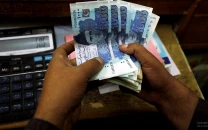Education system casting shadow over youth's future
Country needs modern, well-structured system to create quality human capital, foster tech development

In August, the government of Pakistan organised two important events – a youth conference and the launch of a district education performance report.
The National Youth Conference celebrated the youth engagement and empowerment policy of the government. The prime minister highlighted a long list of youth engagement programmes and opportunities. The chief of army staff emphasised the need for a holistic approach to engagement, education and skill development.
Both unanimously highlighted that youth is Pakistan's future and through youth development and providing them with opportunities, Pakistan can move forward.
Simultaneously, the government launched a district education performance index report. Its findings are disturbing and contrary to the claims of the government. Pakistan could only score 53.4% on the index, which should jolt the government. It is shocking to note that of the 134 districts, more than 50% (77 districts) fall into the low-performance category.
Their schools accommodate almost 25.6 million children while out-of-school kids number 26.5 million, which is alarming and can be called a national crisis. It is also against the vision of the father of the nation, the Quaid-e-Azam.
He envisioned a Pakistan with a modern, well-structured and efficient education system. He believed that education is fundamental to personal growth and building a nation.
Education helps create quality human capital, gives a push to innovation and technological development and paves the way for a respectable status among nations. This way, we can create a prosperous society and enjoy the dividends of development.
Therefore, right after the independence, the Quaid-e-Azam advised the government to organise the All Pakistan Education Conference. It was the first conference of Pakistan, held in November 1947, just three months after the country's creation.
He asked for target-oriented interventions in the education sector and underlined the need for focusing on scientific and technological education to compete with the world and reap the benefits of modern economic structure. He said, "Do not forget that we have to compete with the world, which is moving very fast in this direction."
The All Pakistan Education Conference and Jinnah's vision gave impetus to the debate on a better education structure for achieving rapid growth and the welfare of people on a sustainable basis. This culminated in the establishment of the Commission on National Education in 1959.
The commission worked to refine the policy and implementation framework and proposed several reforms. The education conference and commission suggested greater focus on scientific and technological education, and equal opportunities for both men and women as well as all groups without any discrimination.
On the other hand, the Constitution of Pakistan unambiguously committed through Article 37-B and Article 25-A that the state would provide education to every child. Article 37-B says, "State shall be responsible for eradication of illiteracy and provision of free and compulsory education up to secondary level, within minimum possible time."
Similarly, Article 25-A – Right to Education states, "The State shall provide free and compulsory education to all children of the age of five to sixteen years in such manner as may be determined by law.
Despite the vision of the father of the nation and the commitment to the constitution, Pakistan is still facing an education crisis. There are three major reasons for this low performance.
First, the country could not focus on developing a modern, well-structured and efficient education system. The lack of qualified and specialised teachers further aggravated the situation.
Pakistan was also not able to create sophisticated teacher development infrastructure and competent human resources. There were either no rewards or very poor incentives for the qualified people to become teachers and join the education system.
Successive governments have ignored the teachers. Against all odds, if some qualified persons want to start teaching, the system makes sure that they do not survive for long. The low-quality education infrastructure and human resources have badly impacted the overall performance of the education system and the quality of education.
Second, budgeting is a major issue, both in terms of allocation and utilisation. The government does not allocate resources according to the need for the education infrastructure. From primary to tertiary levels, educational institutions have to struggle to manage resources. For example, many universities are facing a financial crisis. Financial resources and infrastructure are even worse at lower levels.
In addition, the budget allocation and utilisation do not follow the educational investment philosophy; rather it follows the expenditure approach, hurting the performance and quality.
Therefore, Pakistan should adopt a system that can cater to the needs of education, including higher education, but with necessary lifelong skills. The education budget must be allocated based on the theory of "investment in education" and the expenditure approach should be avoided.
According to theory, the allocation is an investment if it is done according to the needs and demands of the market, and in a balanced way. Expenditure-focused allocations will not serve the purpose.
Third, unfortunately, instead of addressing the issues, the government has chosen to shift its responsibility by promoting the private sector. Since the 1980s, private educational institutes have been thriving due to privatisation-friendly policies.
According to the Pakistan Education Statistics Report, private institutions now comprise 38% of the total number of educational institutions and cater to the educational needs of 44% of children (22.70 million). The same is true for the skill development sector.
There is also a shortage of quality public professional and skill development institutions. Again, the private sector is a major player. According to the Education Statistics report, the private sector constitutes 56% of the skill development and vocational institutes.
Moreover, the government could not mobilise the business community to fulfill their obligations in the true spirit of the Apprenticeship Ordinance. The business community has the slightest interest in fulfilling their obligation.
These factors raise the cost of acquiring skills by the youth and contribute to a lower human capital formation. According to a recent report of the World Bank, Pakistan's Human Capital Index only has a value of 0.41. It should be a matter of concern.
This indicates that the productivity of Pakistan's human capital is only 41%, which is very low compared to the world, even the developing countries.
In conclusion, Pakistan must understand that providing quality education and skills will lead to youth development and fulfill the dream of the independence leaders of the country. Otherwise, the youth dividend will become a youth curse. The writer is a political economist and a visiting research fellow at Hebei University, China


1728020501-0/Express-Tribune-Web-(13)1728020501-0-208x130.webp)
















COMMENTS
Comments are moderated and generally will be posted if they are on-topic and not abusive.
For more information, please see our Comments FAQ